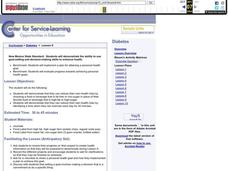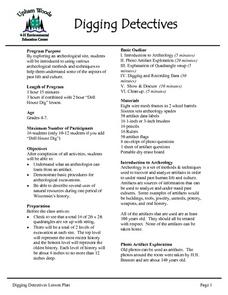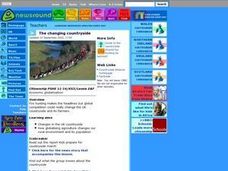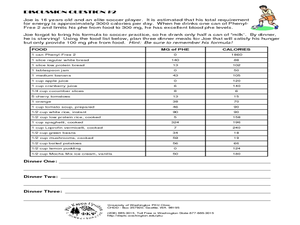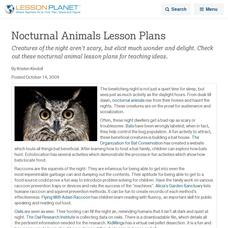Curated OER
The Solar System: Why do we Explore?
Third graders act as scientists. In this property discovery lesson, 3rd graders explore the substance "Oobleck" (cornstarch, water, food coloring). They work in groups to investigate the substance and make observations as a scientist...
Curated OER
DIBETES
Student demonstrates that they can reduce their own health risks by choosing a food or beverage that is fat free or non-sugar in place of their favorite food or beverage that is high-fat or high-sugar. Student identifies a time for...
Curated OER
Five a Day
Students look up and print definitions of fruit and vegatable. They write down their food intake for three days. They identify and categorize fruits and vegetables. They research how fruits and vegetables grow. They bring in their...
Curated OER
Earth Epochs
Young scholars explore earth epochs, i.e, Permian, Precambrian, Cambrian, Ordivician and through pictures they see what life on Earth and animals looked like. They organize Earth Epochs according to years going from greatest to least...
Curated OER
Digging Detectives
Students demonstrate basic procedures for archeological excavations. They explore an archeological site, students using various archeological methods and techniques to determine some of the aspects of past life and culture.
Curated OER
Keeping Warm
Fifth graders measure the temperature of water using a thermometer. They record the temperatures of water on a chart. Students use the temperature data to determine which materials are the best conductors of heat. They discuss their...
Curated OER
Would You Drink This?
Students examine how they affect water quality of those who live downstream after identifying rivers and river basins in Kansas.
Curated OER
Growing Jack and the Beanstalk Plants
First graders investigate how plants grow by growing their own "beanstalk", (after reading "Jack and the Beanstalk") and record their observations daily in a science journal.
Curated OER
Malia
Fourth graders begin their examination of the Hawaiian Islands. Using their island bookmarks from a previous lesson, they work together to put the information into a book. They identify the physical and human characteristics of the...
Curated OER
Conserving Land, Water and Air
Students take a hands on approach to learning about conservation. For this conservation lesson students divide into groups and complete several demos, view a PowerPoint presentation and complete a handout.
Curated OER
Understanding the Steps in a Process
Students read, "Center for Drug Evaluation and Research: FAQs", and discuss with questions embedded in the lesson.
Curated OER
Ground Beef Lab - Open-Faced Tacos
Students will use ingredients and read a recipe to create open faced tacos. The emphasis of the lesson is the kind of preparation that is needed to cook ground beef correctly to avoid diseases associated with improper preparation...
Curated OER
The Changing countryside
Students draw a poster showing the costs and benefits of opening up Britain's farmers to the global marketplace. They use a piece of A4 or A3 paper in landscape. Students draw a vertical line to split the page in two. On the left...
Curated OER
Stations for Liquids
In this liquid worksheet, 6th graders study different types of liquids and liquid conversations. Students respond to 22 questions comparing beverages, milk, and soups.
Curated OER
Is Radio 1 British enough?
Students read the story Radio 1 defends not playing enough UK tunes. Students are then asked: What are the benefits of having a mix of musical cultures in a country?, Do countries lose a sense of identity when other cultures are added?...
Curated OER
Eggs
Students know the following parts of an egg as the yolk, white, shell, membrane, chalaza, and air sac. They also sequence the growth of the chick in the egg. An egg is broken and students touch, smell and see it. They locate the six...
Curated OER
Observing Plants
Students identify how plants affect the survival of a caterpillar and what plants need to survive. They plant three bean seeds in the three containers, placing two containers at a sunny window and the third one in a dark closet and label...
Curated OER
Awesome Animals
Students collect data from classmates about their favorite animal. They use the ClarisWorks graphing program to enter data, graph results, and interpret data.
Curated OER
Journal of Children of the World
Pupils explore the lives of other children. In this comparing and contrasting lesson plan, students complete a KWL chart on children around the world and use the Internet to compare and contrast these children using different categories....
Curated OER
Water Quality and Temperature
Students evaluate the effects of temperature changes on the metabolic rate of a clam. Conclusion questions are addressed which help students to process and articulate their experiences.
Curated OER
Getting Real: Using Real Life Materials
Students examine many different types of real-life materials such as menus or newspaper articles. They practice filling out job applications or ordering at a sitdown restaurant.
Curated OER
Nocturnal Animals Lesson Plans
Creatures of the night aren't scary, but elicit much wonder and delight. Check out these nocturnal animal lesson plans for teaching ideas.
Curated OER
Dietary Fiber Lab
Students bake a variety of cakes experimenting with the amount of fat and fiber in each. They sample the cakes and compare the effects of differing ratios.
Curated OER
Thanksgiving Web Quest
Students review the reasons why Thanksgiving is celebrated in the United States. Using the internet, they research the history of the holiday and discover what the first Thanksgiving was like. They also examine a typical menu for a...



